#to triangulate the exact ways that a 1920s ttrpg would suck
Explore tagged Tumblr posts
Text
So I have been hashing out a hypothetical RPG from c. 1922 in the Little-Wars-becomes-D&D-timeline created based on these rules by people who didn't like Wells's game, and I have come to the conclusion that a surprisingly large portion of pbta-type stuff is just baseball.
Or, phrased another way, Our National Ball Game already has many of the mechanics we associate with, like BitD and such: clocks (rounding the bases), 2d6 rolls producing various outcomes per move (only one move—at-bat—but that one move has about a dozen potential outcomes roughly corresponding to different position and effect), and even the conception that one roll implies both action and reaction (the batter's roll also says what the fielding team does to stop their advance).
The wild thing is that, by following the natural implication of two teams playing against each other, this game is getting into the same space as Fellowship or BOB where the antagonistic force is represented as an opposed force of players with access to more or less the same mechanics as the protagonists. The oddball thing here is that the good guys and bad guys end up taking turns being the ones who roll dice to do things, and that they give up the dice after enough bad rolls.
On the other hand, instead of stats there's a vague suggestion that certain characters should avoid rolling for feats they would be unfit to perform, and the rules makes no assumptions about players' ability to follow game procedure but do presume a load-bearing ability on the part of the players to just freestyle large sections of narrative.
I'm spinning this off of the main thread about tracing the origin of the term "d66" because it's not strictly germane to the topic – none of these examples actually use the term "d66" to describe their dice-rolling methods – but I'm going to post it anyway as a matter of general interest: following a conversation with Tumblr user @notclevr, it appears that before tabletop wargames (and, nearly concurrently, tabletop RPGs) got their hands on the mechanic, the principal (though by no means exclusive) users of the old "roll a six-sided die twice, reading one die as the 'tens' place and the other die as the 'ones' place" trick may have been tabletop American baseball simulators.
The most notable example of the type – and the only well-known example still in publication today – is J Richard Seitz' APBA Baseball, first published in either 1950 or 1951 (accounts vary). In this game, a d66 roll is cross-referenced with a card representing the active player and a "board" representing the current situation on the field:
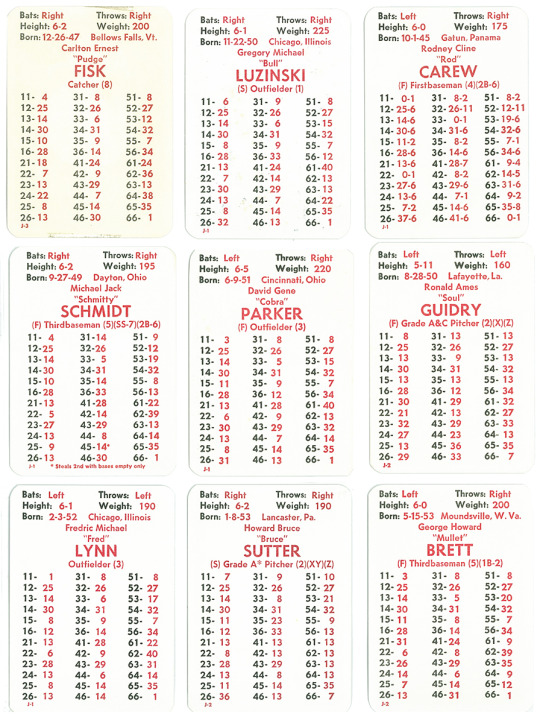
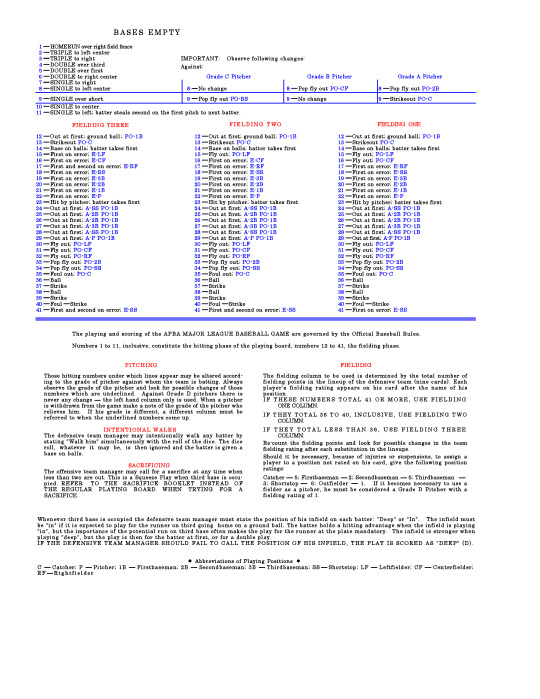

For example, with Carlton Fisk at bat, a d66 roll of 31 would yield a result of "8". Assuming for the sake of argument that the situation on the field is a runner on first and a grade C pitcher, consulting the "Runner on First Base" board, this corresponds to an outcome of "SINGLE—line drive to left; runner to third".
(This example is, strictly speaking, incorrect, as Carlton Fisk didn't have his major league debut until 1969 and I'm using the wrong lookup tables for any year in which he played, but you get the idea!)
Interestingly, APBA Baseball is not the first game to use this setup. It's heavily derived from Clifford Van Beek's National Pastime, a game whose patent was registered in 1925, though it wasn't actually published until 1930. Even at a glance, the similarities are substantial:
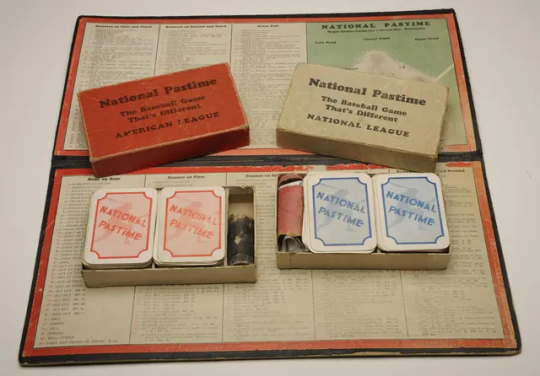
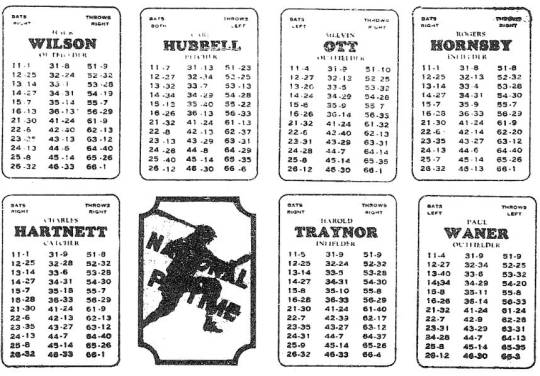

Indeed, though National Pastime's lookup tables are much simpler than APBA Baseball's, where they overlap they're often word for word identical. It's generally accepted that Seitz plagiarised National Pastime without credit when creating APBA Baseball (ironically, given his own famously combative stance toward alleged imitators!), though he was within his rights to do so, as National Pastime had fallen into the public domain by the time APBA Baseball was published.
We can go back even further, though. As far as I've been able to determine, the earliest known tabletop baseball simulator to use d66 lookup tables for resolving plays is Edward K McGill's Our National Ball Game, first published in 1886:


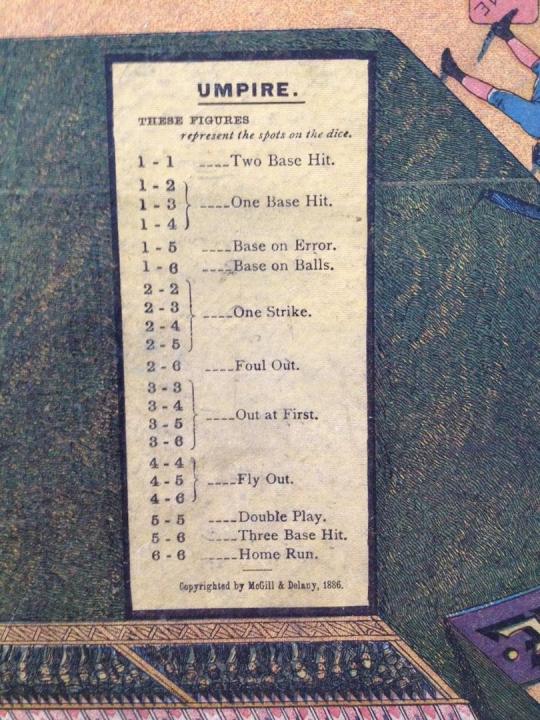
A copy of the game's 1887 US patent application can be downloaded here. This one uses an unusual 21-entry variant of the standard d66 lookup table in which the order of the rolled digits is insignificant, with doubles being half as likely as non-doubles rolls; it's unclear whether McGill was aware of this when he laid out the table. Unlike later incarnations of the genre, there are no individual player statistics, with all at-bats being resolved via the same table.
#using my extensive knowledge of the design trends in early 1900s board games and 1970s-80s ttrpgs#to triangulate the exact ways that a 1920s ttrpg would suck#FYI a home run (6-6) immediately fills all of your side's progress clocks#such that you can meaningfully strategize the order that players make rolls#so that someone can be a clean-up hitter
2K notes
·
View notes
Text
#using my extensive knowledge of the design trends in early 1900s board games and 1970s-80s ttrpgs #to triangulate the exact ways that a 1920s ttrpg would suck (via @paradoxius)
I'm spinning this off of the main thread about tracing the origin of the term "d66" because it's not strictly germane to the topic – none of these examples actually use the term "d66" to describe their dice-rolling methods – but I'm going to post it anyway as a matter of general interest: following a conversation with Tumblr user @notclevr, it appears that before tabletop wargames (and, nearly concurrently, tabletop RPGs) got their hands on the mechanic, the principal (though by no means exclusive) users of the old "roll a six-sided die twice, reading one die as the 'tens' place and the other die as the 'ones' place" trick may have been tabletop American baseball simulators.
The most notable example of the type – and the only well-known example still in publication today – is J Richard Seitz' APBA Baseball, first published in either 1950 or 1951 (accounts vary). In this game, a d66 roll is cross-referenced with a card representing the active player and a "board" representing the current situation on the field:



For example, with Carlton Fisk at bat, a d66 roll of 31 would yield a result of "8". Assuming for the sake of argument that the situation on the field is a runner on first and a grade C pitcher, consulting the "Runner on First Base" board, this corresponds to an outcome of "SINGLE—line drive to left; runner to third".
(This example is, strictly speaking, incorrect, as Carlton Fisk didn't have his major league debut until 1969 and I'm using the wrong lookup tables for any year in which he played, but you get the idea!)
Interestingly, APBA Baseball is not the first game to use this setup. It's heavily derived from Clifford Van Beek's National Pastime, a game whose patent was registered in 1925, though it wasn't actually published until 1930. Even at a glance, the similarities are substantial:



Indeed, though National Pastime's lookup tables are much simpler than APBA Baseball's, where they overlap they're often word for word identical. It's generally accepted that Seitz plagiarised National Pastime without credit when creating APBA Baseball (ironically, given his own famously combative stance toward alleged imitators!), though he was within his rights to do so, as National Pastime had fallen into the public domain by the time APBA Baseball was published.
We can go back even further, though. As far as I've been able to determine, the earliest known tabletop baseball simulator to use d66 lookup tables for resolving plays is Edward K McGill's Our National Ball Game, first published in 1886:



A copy of the game's 1887 US patent application can be downloaded here. This one uses an unusual 21-entry variant of the standard d66 lookup table in which the order of the rolled digits is insignificant, with doubles being half as likely as non-doubles rolls; it's unclear whether McGill was aware of this when he laid out the table. Unlike later incarnations of the genre, there are no individual player statistics, with all at-bats being resolved via the same table.
#gaming#tabletop games#board games#baseball#apba baseball#national pastime#our national ball game#game design#history#swearing#and if you think tabletop RPGs are preoccupied with big stupid dice tables *now*#just imagine
2K notes
·
View notes